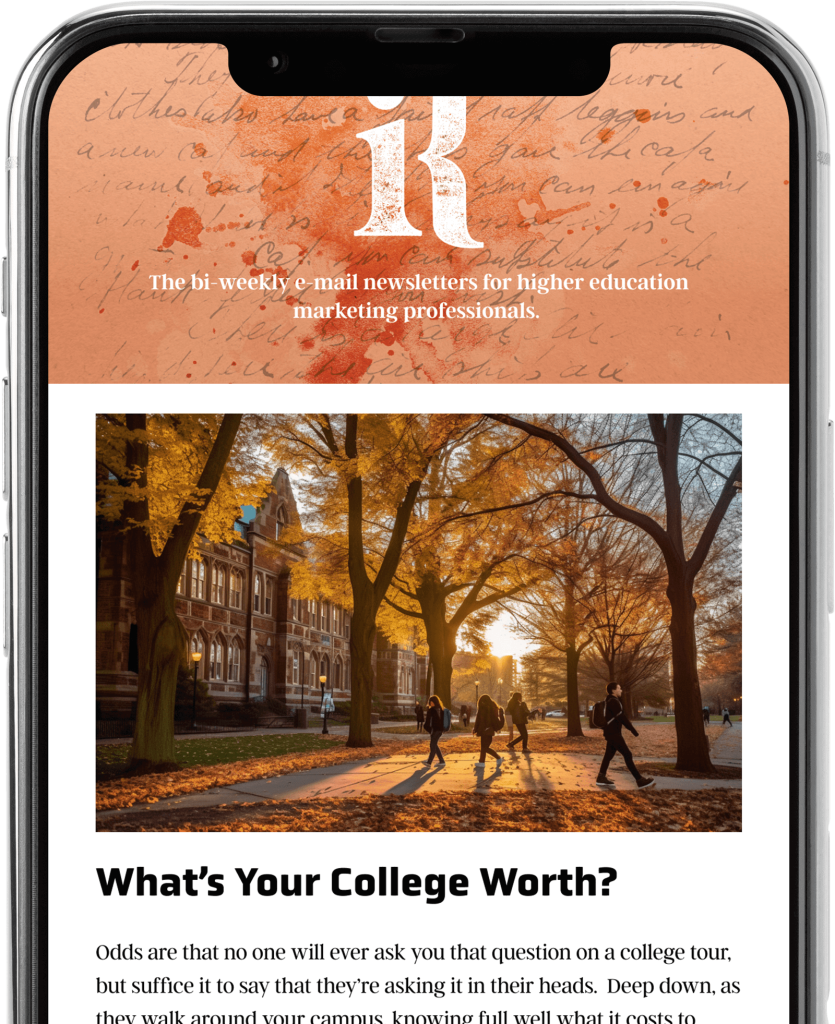HIGHER EDUCATION BRAND
The Power of Brand in Higher Education Marketing

As a part of the marketing realm, brand is a term that comes with several connotations, misconceptions, and a variety of definitions. It is a confusing term that we hear a great deal about in the popular lexicon, but do we truly stop and thinking about what it means? People often say that Apple, Nike, Mercedes, and Amazon have some of the most powerful brands in the world. But why? We can’t understand the answer to that question without stopping to think about what brand means. In truth, there are multiple ways to define ‘brand.’
For the purposes of developing a working framework for the overall practice of marketing, though, we will be defining brand as the intangible set of associations wrapped around a product or service that lives in the hearts and minds of consumers.1 I find it helpful to memorize this definition as a working tool to apply to any conversation or endeavor with brand-related implications—be it a new name for a product or an idea for a campaign.
Transitively, we can apply this definition to a higher education environment by defining brand as the intangible set of associations wrapped around our college or university that lives in the hearts and minds of our students, alumni, faculty, and staff.
It’s important to note, also, what a brand is not. It’s not a logo, it’s not a name, and it’s not a brochure or website. While these things are all critical and should be carefully considered, designed, and produced, those are all part of the brand’s identity. We’ll get to those in good time.
The key term in our definition is associations. Associations are those extensions of our institution that connect us to audiences. I’ve never set foot on the campus of the University of Southern California (USC), but I associate the institution with the City of Los Angeles, palm trees, sunshine, actor Will Ferrell, football stars Reggie Bush and Matt Leinart, and more recently Bronny James, son of NBA legend LeBron James. For better of worse, those are the things that come to mind.
Other institutions have other associations. When I think of Notre Dame I think of the Catholic Church, football, a golden dome, and the move Rudy. I associate Harvard with Boston, Good Will Hunting, intelligence, and the founding of companies like Microsoft and Facebook. I think about Duke University and immediately think of an excellent medical school but also an incredible basketball program with an iconic coach and a whole host of personalities that inspire some while infuriating others. What do people associate your university with?
Intangible is also an important aspect of the definition worth mentioning. When you think about it, a brand (remember, not a logo or campaign execution) is not a tangible instrument or thing. You can’t put a brand on a table and look at it or, as New York University Stern School of Business Professor Scott Galloway is known to say, “you can’t drop a brand on your foot.”
As such, these intangible associations exist in the hearts and minds of our many constituent groups: from the students who attend our institution to those who graduated decades ago and consider us with their short and long term philanthropic activities.
It’s worth mentioning, of course, that associations can be both positive and negative. For all its success on the football field, USC experienced past scandals in its football programs that made some question its credibility. Johns Hopkins University, likewise, faced negative brand associations when Professor Wendy Osefo assumed a role on the Bravo television show The Real Housewives of Potomac. ‘Housewife’ reality shows are commonly known as guilty pleasures for their portrayal of unsavory topics, situations, and conduct. The Chronicle of Higher Education described it this way:
To point out the obvious: It’s unusual for any professor to star on any reality show, let alone for a Johns Hopkins professor to star on a Bravo series. The university’s image is closely aligned with world-class research, public health, and Covid-19 tracking. The Real Houseviews image is closely aligned with promotional alcohol, plastic surgery, and sequins. One imagines the reputational mismatch is uncomfortable, at least for Hopkins, the far more buttoned-up of the two brands.2
This is an example of an institutional brand association that is potentially problematic if not negative: a minus instead of a plus for the organization. Alas, many of an institution’s negative associations are often out of their control: scandals, crises, or breaches of behavior that leave a mark aren’t often even known to the institution until it’s too late.
It’s often the job of the marketing department and/or institutional leaders to manage these associations. In some cases, we must work to create these associations. In one recent client engagement, our firm noticed that a leader of a very prominent organization (we’re talking about worldwide name recognition) was coming to campus to present an award. It flew under the radar of some because the person’s name wasn’t as well known as the organization involved. We were able to reach out and coordinate an interview with the individual which not only made for interesting content for the blog, it created an association between the college, the person, and the organization represented, which happened to be one that most anyone would want to be affiliated. The photo, the content, and the thought of a visit had elevated the brand in a way that a celebrity spokesperson does. These are the same reasons why Subway pays NBA legend Steph Curry while Jersey Mike’s retains actor Danny DeVito to appear in sandwich commercials: different, yet positive associations.
Another recent example of a brand association is the University of Colorado’s hiring of head football coach Deion Sanders. Sanders, widely popular with the athletic community and popular culture, brought a charismatic and positive aura to not only the football team, but the entire school. His impact on the school, which has been widely documented, included a record number of applications of first-year students, up nearly 20% from the previous year. Sanders, who is African-American, has also been credited for the school’s 50.5% increase in Black applicants. That’s quite an impactful association.
These examples represent what brand management is about: managing the college’s brand associations such that the positive associations far outweigh the negatives and the net calculation thereof is decidedly positive. And thanks to decades of study in the field of brand management—from academia no less—there is a powerful framework for achieving that. In short, your college’s brand needs a vision.
1 Professor Scott Galloway’s definition.
2 The Real Housewife of Johns Hopkins University, The Chronicle of Higher Education, Emma Pettit, October 19, 2023
Like what you're reading?
Subscribe to our newsletter to get the latest insights in Higher Education and thought leadership.


